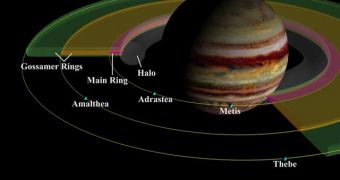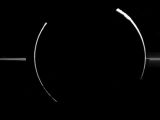Although they are not as visible as Saturn's beautiful rings of particles, Jupiter's rings were in fact discovered in 1979 during the first Voyager mission. Until 1995, when the Galileo spacecraft entered orbit around Jupiter, scientists had in fact no image of the thin, mysterious features around our solar system's largest planet, which were thought at the time to be created by matter stirred up by collisions between Jupiter's inner moon and meteoroids caught in the powerful gravitational field of the planet.
By 2003 the mission of the Galileo spacecraft had ended, but many questions related to Jupiter's rings remained unanswered. Anomalies such as the rings spanning into space well beyond the orbit of the moon Thebe or the fact that part of the ring system was tilted in relation to the main plane of the rings simply didn't fit into the theoretical predictions. According to a recently published study, these anomalies are determined by alternating light and shadow.
"As they orbit about the planet, dust grains alternately discharge and charge when they pass through the planet's shadow. These systematic variations in dust particle electric charges interact with the planet's powerful magnetic field. During these interactions dust particles are being pushed well beyond the outer orbital boundary and even change their inclination, or orbital orientation, to the planet", says astronomer Douglas Hamilton from the University of Maryland.
The data was extracted from computer simulations based on measurements such as dust grain size, speed and orbital orientation, collected during the crossing of the Galileo spacecraft through the planet's rings in anticipation for the inevitable impact with Jupiter. Along with German researcher Harald Kruger, Hamilton showed that the data revealed by the simulations matched the imaging data that predicted the orbital eccentricities.
"Within our model we can explain all essential structures of the dust ring we observed", says Kruger. The study can be further extended to the study of other gas giants and their particle rings.
"The icy particles in Saturn's famous rings are too large and heavy to be significantly shaped by this process, which is why similar anomalies are not seen there. Our findings on the effects of shadow may also shed some light on aspects of planetary formation because electrically charged dust particles must somehow combine into larger bodies from which planets and moons are ultimately formed", said Hamilton.

 14 DAY TRIAL //
14 DAY TRIAL // 
